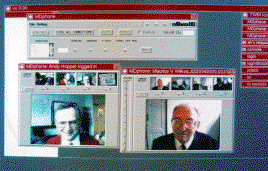
AT&T Laboratories
Cambridge
 |
AT&T Laboratories |
||||
Medusa provides a powerful, flexible framework for applications involving networked digital audio and video. It takes a modular approach to the construction of complex systems and exploits a wide range of hardware devices unified by a common interface to an ATM network.
Unlike other multimedia systems where the input-output devices are attached to a workstation bus, the workstation is connected to the network, Medusa peripherals are attached directly to the ATM network. Called Smart ATM Modules (SAMs), these include cameras, audio devices, networked framebuffers, processor farms and disk drives.
The software components of the Medusa Applications Enviroment are known as Medusa Modules and can be both hardware or software based. For example, a Module for performing data compression could be implemented by special purpose hardware, a software package running on a workstation or software running on a SAM. Medusa offices have typically four microphones and speakers to provide CD quality audio and four cameras - although up to sixteen cameras is possible. The number of displays in the Medusa office varies considerably, but often includes a standard workstation or X terminal and a flat screen LCD display, known as the Video Tile, connected directly to the ATM network which can be hung on the wall or moved around the desk.
Publications outline the application level environment, and its architectural design.

For comments, suggestions and further information please contact us.
Copyright © 2001 AT&T Laboratories Cambridge